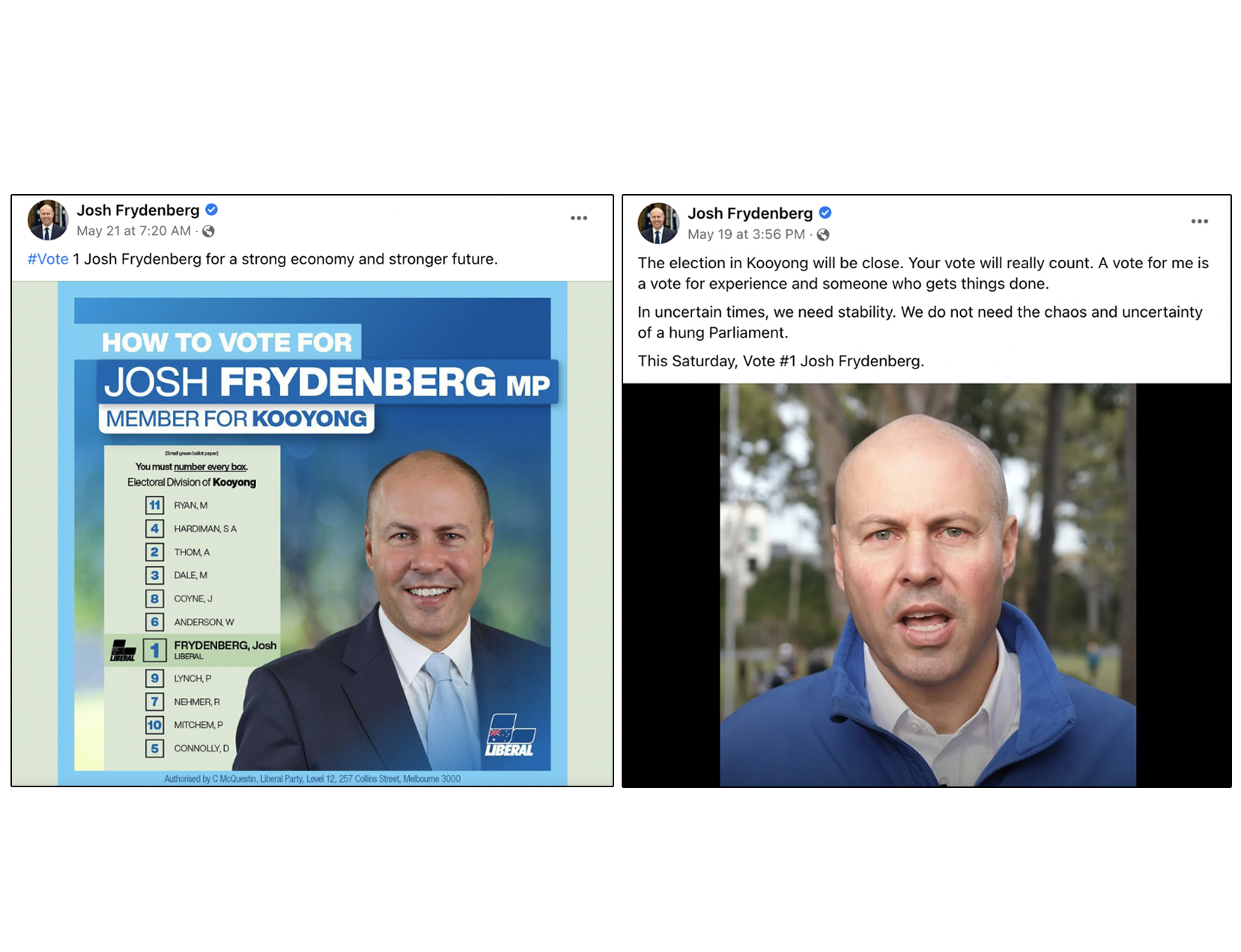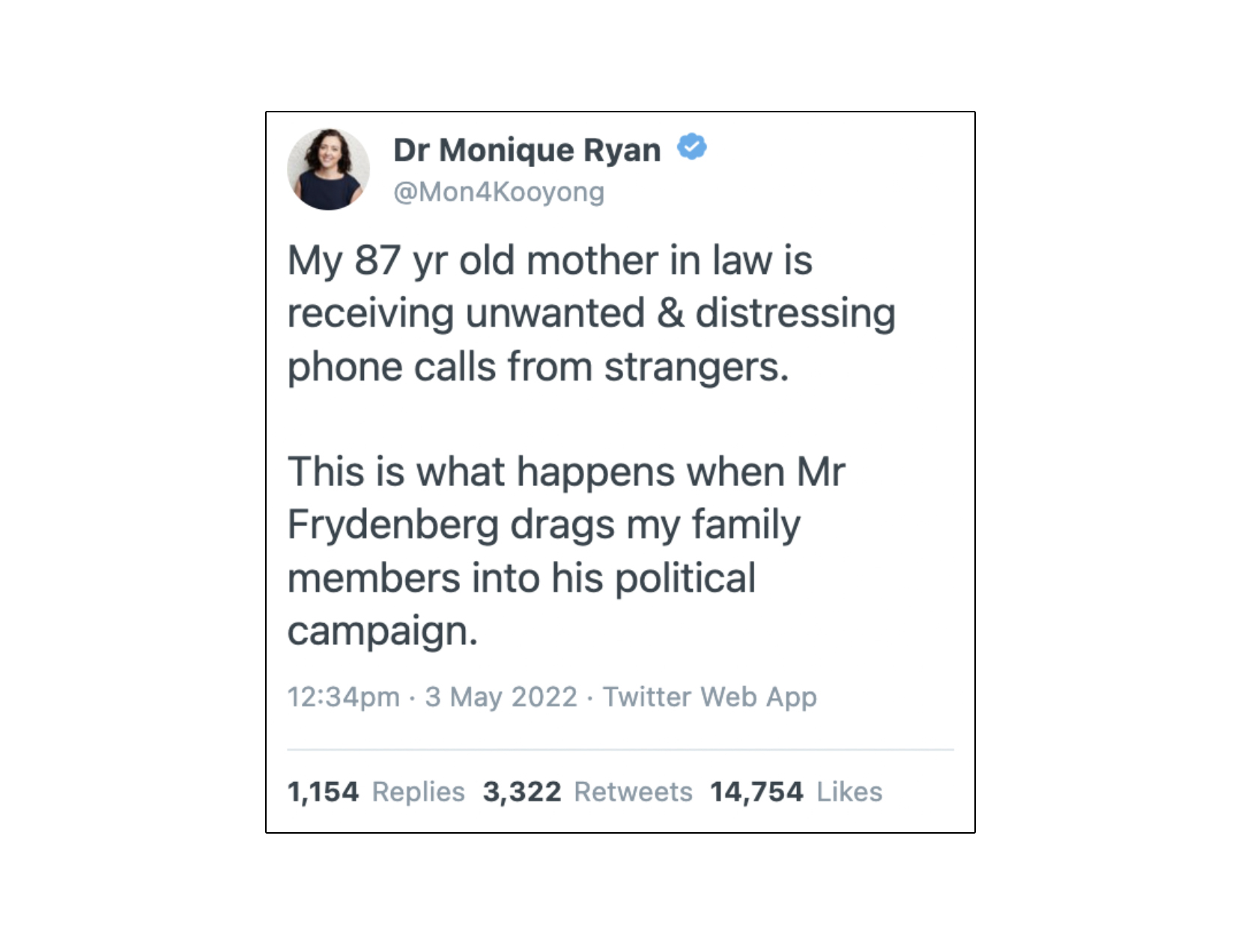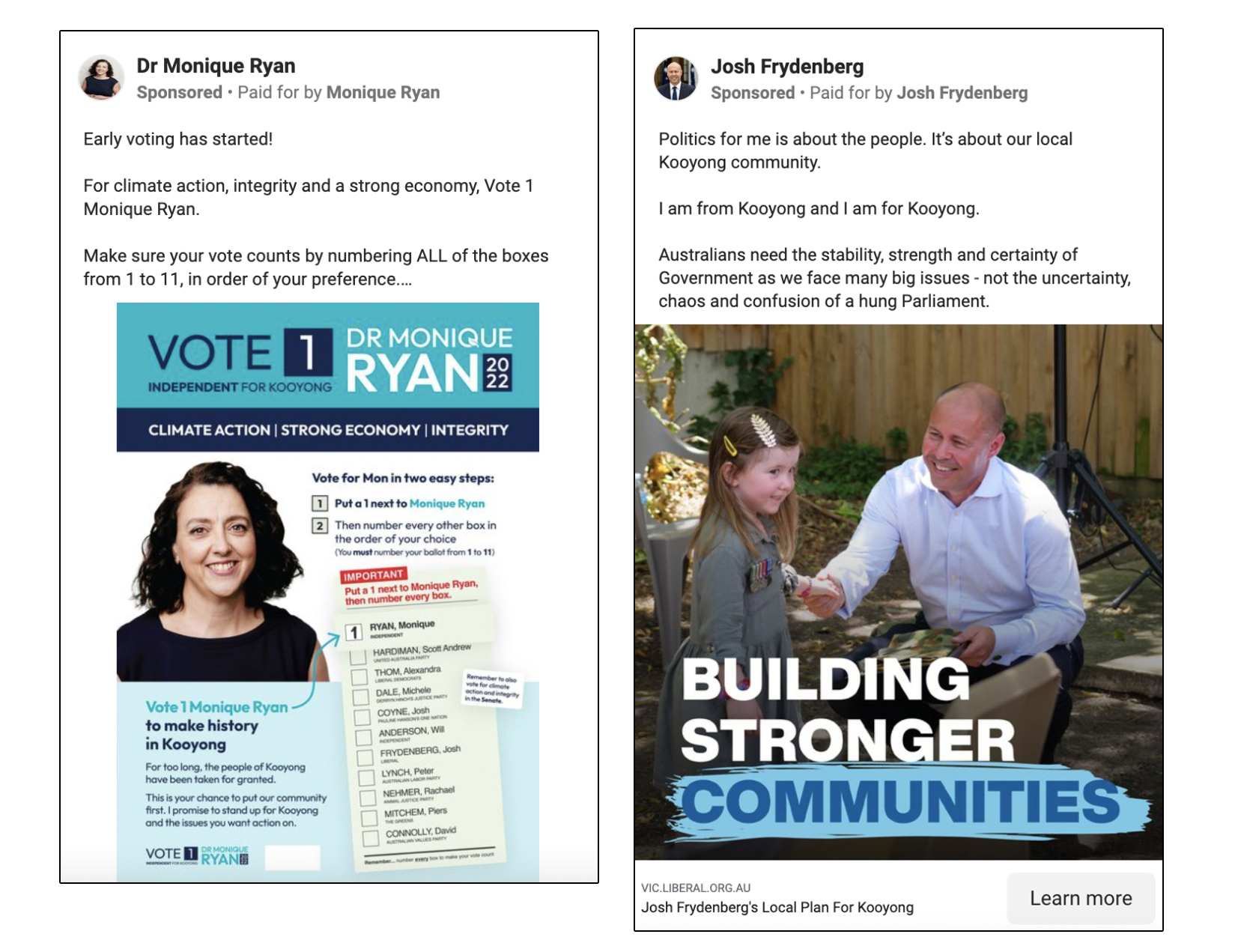
How Monique Ryan rewrote history in Kooyong with an innovative social media strategy
Freshly minted independent MP Dr Monique Ryan’s historic win in the federal seat of Kooyong marked a rupture in the electoral status-quo, suggesting a waning influence of legacy media in shaping the election result.
Former treasurer Josh Frydenberg’s extensive billboard advertising and generally supportive stories published by News Corp media were no match for the community-focused social media campaign led by Dr Ryan and her supporters.
According to research by RMIT Factlab:
Tik Tok attracted and engaged young voters, who make up the largest age group in the Kooyong electorate. Dr Ryan’s TikTok received more than 40,000 likes and recorded 270,000-plus views. Tik Toks posted by Youth4Mon volunteers garbered more than 500,000 views.
Incumbent Josh Frydenberg’s social media campaign failed to reach Mon4Kooyong’s levels of engagement.
Dr Ryan’s advertising campaign embraced a far wider audience, bolstered by frequent posts and higher interactions on her campaign Facebook page.
The electorate
The Kooyong electorate in Melbourne’s leafy inner-eastern suburbs is home to 166,419 people.
The electorate’s gender divide stands at 49.5 per cent female and 50.5 per cent male.
People aged between 18 and 34 constitute the largest age group, accounting for 26.2 per cent of the electorate.
Households in the seat of Kooyong are among the wealthiest in the country, with a median weekly income of $2,036.
Until the ousting of Mr Frydenberg, the seat of Kooyong had been held by a conservative party member since federation, and by the Liberals since World War II.
What were Dr Ryan and Mr Frydenberg messaging online?
FactLab studied the social media campaigns of Dr Rytan and Mr Frydenberg in the lead up to the election, namely the period between April 1 and May 20.
April 1 - May 20 |
Monique Ryan |
Josh Frydenberg |
Number of Twitter followers |
30.8k |
119.2k |
Number of tweets or retweets |
371 |
100 |
Increased Twitter following |
+ 13k |
3.461k |
Number of Facebook followers |
3.8k |
78k |
Number of Facebook posts |
185 |
90 |
Increased Facebook following |
+2.1k |
+1.6k |
Number of Tik Tok followers |
2,989 |
732 |
Number of Tik Tok videos |
28 |
N/A |
Across Facebook and Twitter, Mr Frydenberg mainly communicated policies tied to the Morrison government and promoted his record as Treasurer.
He regularly drew on the broader Liberal Party narrative that independents were ‘‘fake” and that a vote for “teal” candidates would be a vote for chaos and instability in parliament.

Mr Frydenberg’s election posts appeared to be at odds with the prevailing political climate, particularly in regards to perceived government inaction on climate change and gender equality.
He often resorted to negative campaigning, avoiding referring to Dr Ryan by name and casting her as a “fake” or a “so-called” independent.
Although Dr Ryan campaigned strongly on climate action and gender equality, FactLab could not identify any posts issued by Mr Frydenberg on these issues.
Moreover, the dozens of posts promoting older, high profile politicians and football clubs failed to hit the mark, evidenced by the subsequent low levels of engagement.
Dr Ryan, on the other hand, led a community-focused social media campaign of positive messaging to promote a commitment to climate action, integrity in politics and gender equality.
While she was critical of the Morrison government’s climate policies, she rarely attacked her political opponents. A notable exception, however, was her criticism of Mr Frydenberg following his claim that Dr Ryan’s mother-in-law was intending to vote Liberal. These posts generated significant levels of engagement in support of Dr Ryan.

FactLab observed several strategies employed by Dr Ryan across various social media platforms to boost engagement and extend the reach of her messaging.
For example, Dr Ryan and her team posted dozens of times a day and regularly amplified voices in the community through the publication of savvy “voter profiles”, which allowed her to promote how her election platform aligned with the values and needs of the electorate.
Dr Ryan also used social media to advertise events for meeting with voters, such as weekly pizza nights and walks in the park.
Most notably, Dr Ryan established a Mon4Kooyong Tik Tok page two months out from the election in a bid to attract younger voters. The page attracted almost 3,000 followers and received more than 41,000 likes.
Most of her campaign’s Tik Tok videos included “voter profiles” and snippets of Dr Ryan’s public debate with Mr Frydenberg in which she discussed key subjects such as climate action, electric vehicles and the economy.
Arguably more significant was the Youth4Mon volunteers who established a Tik Tok account dedicated to Dr Ryan’s campaign, which recorded 65,000 likes. The 31 posted videos attracted more than 500,000 views.
In the final days of the campaign, it was clear that Dr Ryan had reached critical mass on social media with a last-minute call-out for donations to assist her legal fight to allow Australians with COVID-19 to vote raising $126,000 in just four hours.
Reach and impact: how the social media campaigns fared
FactLab analysed the two candidates’ reach across social media for the period April 1 to May 20.
Dr Ryan tweeted or retweeted 371 times, which was significantly more than Mr Frydenberg (100 tweets/retweets).
The candidates’ top 10 performing election tweets (measured by the number of retweets), show that overwhelmingly, Dr Ryan had greater reach and impact than Mr Frydenberg. In fact, her tweets outperformed those of a number of political leaders and commentators.
.jpg)
Tik Tok
Dr Ryan gained almost 3,000 Tik Tok followers during the election campaign, with her page receiving more than 41,700 likes.
Her top performing Tik Tok videos included snippets of her debate with Mr Frydenberg where she outlined her policies on climate action (80,200 views), batteries for electric vehicles (73,200 views) and the economy (44,700 views).
Other top performing videos included two voter profiles of former Liberal voters, one woman and a man. The former attracted 19,700 views; the latter, 13,000.
Dr Ryan’s Tik Tok success was further evident in the number of videos tagged #MoniqueRyan and #Mon4Kooyong that were viewed more than 500,000 times.
Hard sell: how much did the candidates spend on social media advertising?
Between January 1 and May 21, Dr Ryan spent at least $277, 350 on advertising across Facebook, Google and YouTube, compared to Mr Frydenberg’s $286,350 minimum.
Importantly, while Mr Frydenberg spent marginally more on social media advertising, Dr Ryan’s ads had greater impact and reach.
According to QUT's PoliDashboard Facebook Political Ads Module, Mr Frydenberg spent more on Facebook campaign ads than Dr Ryan.
From January 1, Mr Frydenberg spent between $202,800 and $267,500 on Facebook ads, which achieved more than 5.2 million impressions.
Dr Ryan, on the other hand, spent between $157,800 and $204,000 on Facebook ads, yielding more than 7.3 million impressions.
How far did these Facebook election ads reach?
While Mr Frydenberg spent more on Facebook, the reach of his ads was not as significant as those of Dr Ryan.
One of the former treasurer’s most successful Facebook advertisements recorded between 200,000 and 250,000 impressions, about half the impressions of Dr Ryan’s best performing ad which recorded between 450,000 and 500,000 impressions. Another of Dr Ryan’s advertisements drew between 250,000 and 300,000 impressions.

Google and YouTube
Dr Ryan spent more on advertising on Google and YouTube and, similar to her Facebook success, her ads reached a larger audience than those of Mr Frydenberg.
According to Google’s Transparency Report for Political Advertising in Australia, Dr Ryan spent $119,550 on four Google and YouTube ads over the period from December 2021, whereas Mr Frydenberg spent $83,550 on 15 ads.
While the advertisements of both candidates targeted voters of all ages, Dr Ryan’s ads specifically targeted the Kooyong electorate, whereas Mr Frydenberg targeted broader Melbourne.
One of Dr Ryan’s Google ads received more than 10 million impressions. Two of her YouTube ads each received between 1 and 10 million impressions, with the remaining recording between 100,000 and 1 million impressions.
Mr Frydenberg’s eight Google ads, on the other hand, recorded just 57,000 impressions each on average. Four of his YouTube ads each received between 100,000 and 1 million impressions, with the remaining three YouTube ads recording between 10,000 and 100,000 impressions.
Helping hand: how much did Climate 200 spend on online advertising in support of Dr Ryan and criticising Mr Frydenberg?
According to the Facebook Ad Library, Climate 200 ran 21 Facebook ads in support of Dr Ryan at an estimated minimum cost of $22,000.
One of the most successful Climate 200 ads supporting Dr Ryan recorded between 100,000 and 125,000 impressions. Another recorded between 90,000 and 100,000 impressions.
The data also reveals that young people were most commonly shown these ads in their social media feeds.
Climate 200 also sponsored four Facebook ads that were critical of Mr Frydenberg at an estimated cost of $800. One of these drew between 30,000 and 35,000 impressions.


Acknowledgement of Country
RMIT University acknowledges the people of the Woi wurrung and Boon wurrung language groups of the eastern Kulin Nation on whose unceded lands we conduct the business of the University. RMIT University respectfully acknowledges their Ancestors and Elders, past and present. RMIT also acknowledges the Traditional Custodians and their Ancestors of the lands and waters across Australia where we conduct our business - Artwork 'Sentient' by Hollie Johnson, Gunaikurnai and Monero Ngarigo.
More information